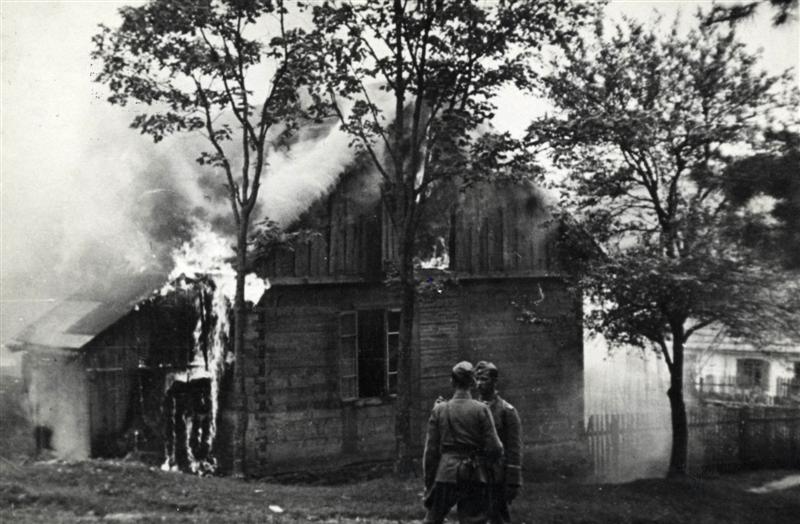The village of Michniów, located at the foot of the Swietokrzyskie Mountains, was completely destroyed on 12-13 July 1943 and its inhabitants, including women and children, were brutally murdered by the Germans. By an act of 2017, the Polish Sejm established the date of 12 July as the Day of Fight and Martyrdom of the Polish Countryside.
During the Second World War, the Germans committed many mass crimes against the inhabitants of Polish villages in the areas of occupied Poland. They were shot, transported to concentration camps and sent to forced labour in the Third Reich. Their property was looted and destroyed. Troops of the German repression apparatus often burned down entire villages. Historians estimate that over 800 Polish villages were annihilated in various ways. The occupation terror affected the villagers, even when they delayed or failed to fulfil compulsory deliveries of agricultural products, i.e. quotas, or refused to go to the Third Reich for agricultural work.
Executions, often of entire families, were carried out when the Germans discovered that they were helping Jewish people in hiding or were active in the Polish underground organisations. Often the bloodiest form of German repression was the decimation of entire villages through murder of their inhabitants, not excluding women and children, looting their property and burning all residential and farm buildings. One of the places of such German bestiality is the village of Michniów, which was burnt down for helping the soldiers of the Home Army. Its inhabitants were murdered on 12 and 13 July 1943.
Before the outbreak of World War II, Michniów was inhabited by around 500 people. Some of them earned their living by working on the land, others were employed in clearing the forests that surrounded the village on three sides. After September 1939, the village was under German occupation in the Radom District of the General Government. The inhabitants of Michniów, like the rest of the rural population conquered by the Third Reich, were forced to deliver compulsory quotas introduced in 1940, the size of which increased with every year of the occupation. In spite of the repression they faced, the inhabitants of the village engaged in underground resistance activities, above all in the structures of the Union of Armed Struggle (ZWZ), which was renamed the Home Army (AK) in February 1942. By the middle of 1943, there were about 40 sworn soldiers of the AK in the village. There was also a cottage gunsmith’s shop in Michniów at this time, where partisans repaired their weapons.
In May 1943, in the middle of the surrounding forests, which was the Wykus wilderness, a grouping of partisan units was formed by Lieutenant Jan Piwnik, aka “Ponury”. It soon numbered 200 AK soldiers. “Ponury” and his squad began a large-scale sabotage activity. As part of this, on the night of 2 to 3 July 1943, he attacked two German trains near the Łączna station on the Radom-Kielce railway track. As a result of the action, according to German data, 8 people were supposed to have been killed and several dozen wounded. Residents of Michniów provided supplies to the soldiers of “Ponury”. This aid, as well as the existing underground formation in the village, was the reason why the German occupation authorities decided to decimate the village. The decision was made during a meeting that took place on 8 July 1943 in Radom. On Sunday, 11 July 1943, a group of German police officers arrived at the site and made a preliminary reconnaissance of the area. On the night of 11/12 July Michniów was surrounded by a double ring of German troops. No one could get out of or into the village. German police entered the village and began arresting the inhabitants who appeared on previously prepared proscription lists. These were created as a result of reports from confidants.
The arrested Poles were brutally beaten while being led to collection points. About ten men were taken to Kielce for detailed interrogations and then they were to be sent to Auschwitz. Several women were deported to forced labour near Hanover. Some of the detainees, meanwhile, were taken to one of the barns, into which the Germans threw grenades and then set it on fire. Many families were also murdered on the premises of individual houses. In total, on 12 July 1943, 102 people were murdered by the Germans in Michniów, including two women and five children aged between 5 and 15 years of age.





